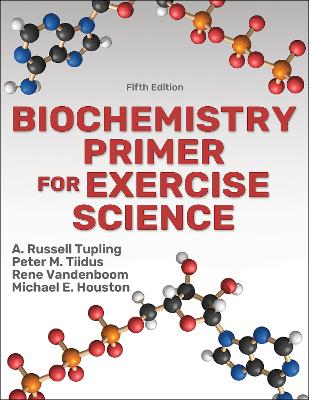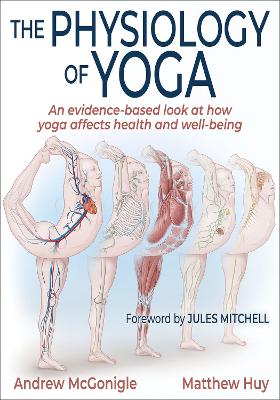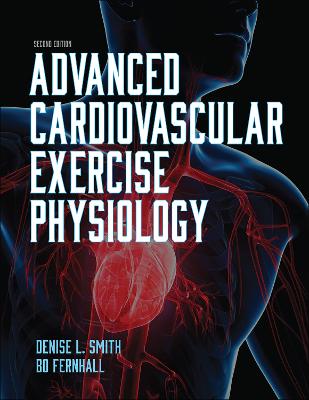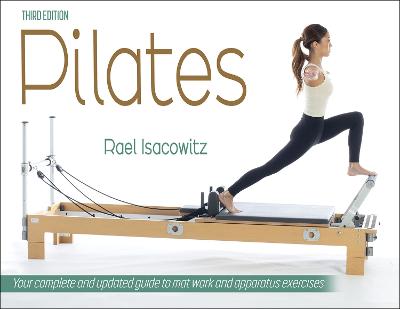Practical Guide to Exercise Physiology
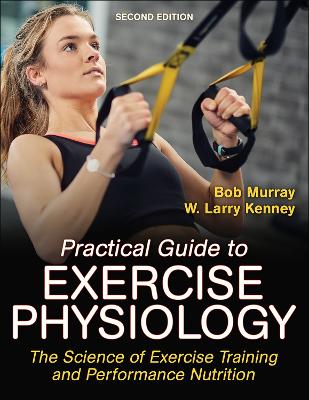 -15%
portes grátis
-15%
portes grátis
Practical Guide to Exercise Physiology
The Science of Exercise Training and Performance Nutrition
Murray, Robert; Kenney, W. Larry
Human Kinetics Publishers
09/2020
248
Mole
Inglês
9781492599050
15 a 20 dias
816
Descrição não disponível.
Part I. Warming Up: Physiology 101
Chapter 1. Muscles Move Us
How Do Muscles Work?
How Do Muscles Adapt to Training?
How Do Muscle Cells Get Bigger and Stronger?
Chapter 2. Food Really Is Fuel
From Food to Energy
How Do Nutrients Fuel Muscle?
What About Vitamins and Minerals?
Water Is a Nutrient, Too
Chapter 3. Muscles Need Oxygen
How Does Oxygen Get to Muscles?
How Does Oxygen Use Relate to Metabolic Rate?
How Does Training Help the Body Use More Oxygen?
Oxygen Delivery and Performance Enhancement
Chapter 4. Fatigue: What Is It Good For?
What Causes Fatigue?
What's the Difference Between Fatigue and Overtraining?
What Role Does Fatigue Play in Adaptations to Training?
Part II. The Science of Training Program Design
Chapter 5. Principles of Designing Training Programs
What Are the Basics of Program Design?
What Makes an Effective Training Program?
Training Terms
Chapter 6. Training to Improve Strength and Muscle Mass
How Do Strength and Mass Increase?
What's the Best Way to Gain Strength and Mass?
What's the Role of Nutrition?
Detraining and Retraining
Chapter 7. Training for Body Weight Control
Weight Loss Is All About Energy Balance
Why Do Some People Have Difficulty Losing Weight?
What's the Best Way to Lose Fat but Protect Muscle Mass?
Chapter 8. Training for Speed and Power
What Are Speed and Power?
What Adaptations Are Needed to Improve Speed and Power?
What Kinds of Training Improve Speed and Power?
What Does a Speed and Power Training Session Look Like?
Chapter 9. Training for Aerobic Endurance
What Are the Main Adaptations to Aerobic Training?
What's the Best Way to Improve Aerobic Endurance?
Should Endurance Athletes Engage in Strength Training?
Why Is Endurance Capacity Important for Sprinters and Team-Sport Athletes?
Part III. Special Considerations
Chapter 10. Heat, Cold, and Altitude
Exercise in the Heat Impairs Performance
Cold Stress Chills Performance
Exercise at Altitude
Chapter 11. Training Children and Pregnant Women
Do Children Respond Differently to Exercise Training?
Can Children Improve Strength With Training?
Should Women Exercise During Pregnancy?
Chapter 12. Training Older Adults
What Changes With Aging?
How Can Exercise Training Benefit Older Adults?
What Considerations Should Be Part of Training for Older Adults?
Index of Common Questions From Clients
Chapter 1. Muscles Move Us
How Do Muscles Work?
How Do Muscles Adapt to Training?
How Do Muscle Cells Get Bigger and Stronger?
Chapter 2. Food Really Is Fuel
From Food to Energy
How Do Nutrients Fuel Muscle?
What About Vitamins and Minerals?
Water Is a Nutrient, Too
Chapter 3. Muscles Need Oxygen
How Does Oxygen Get to Muscles?
How Does Oxygen Use Relate to Metabolic Rate?
How Does Training Help the Body Use More Oxygen?
Oxygen Delivery and Performance Enhancement
Chapter 4. Fatigue: What Is It Good For?
What Causes Fatigue?
What's the Difference Between Fatigue and Overtraining?
What Role Does Fatigue Play in Adaptations to Training?
Part II. The Science of Training Program Design
Chapter 5. Principles of Designing Training Programs
What Are the Basics of Program Design?
What Makes an Effective Training Program?
Training Terms
Chapter 6. Training to Improve Strength and Muscle Mass
How Do Strength and Mass Increase?
What's the Best Way to Gain Strength and Mass?
What's the Role of Nutrition?
Detraining and Retraining
Chapter 7. Training for Body Weight Control
Weight Loss Is All About Energy Balance
Why Do Some People Have Difficulty Losing Weight?
What's the Best Way to Lose Fat but Protect Muscle Mass?
Chapter 8. Training for Speed and Power
What Are Speed and Power?
What Adaptations Are Needed to Improve Speed and Power?
What Kinds of Training Improve Speed and Power?
What Does a Speed and Power Training Session Look Like?
Chapter 9. Training for Aerobic Endurance
What Are the Main Adaptations to Aerobic Training?
What's the Best Way to Improve Aerobic Endurance?
Should Endurance Athletes Engage in Strength Training?
Why Is Endurance Capacity Important for Sprinters and Team-Sport Athletes?
Part III. Special Considerations
Chapter 10. Heat, Cold, and Altitude
Exercise in the Heat Impairs Performance
Cold Stress Chills Performance
Exercise at Altitude
Chapter 11. Training Children and Pregnant Women
Do Children Respond Differently to Exercise Training?
Can Children Improve Strength With Training?
Should Women Exercise During Pregnancy?
Chapter 12. Training Older Adults
What Changes With Aging?
How Can Exercise Training Benefit Older Adults?
What Considerations Should Be Part of Training for Older Adults?
Index of Common Questions From Clients
Este título pertence ao(s) assunto(s) indicados(s). Para ver outros títulos clique no assunto desejado.
Exercise physiology; physiological response to exercise; body response to exercise; adaptions to exercise; physiology of exercise; intro physiology; physiology and fitness
Part I. Warming Up: Physiology 101
Chapter 1. Muscles Move Us
How Do Muscles Work?
How Do Muscles Adapt to Training?
How Do Muscle Cells Get Bigger and Stronger?
Chapter 2. Food Really Is Fuel
From Food to Energy
How Do Nutrients Fuel Muscle?
What About Vitamins and Minerals?
Water Is a Nutrient, Too
Chapter 3. Muscles Need Oxygen
How Does Oxygen Get to Muscles?
How Does Oxygen Use Relate to Metabolic Rate?
How Does Training Help the Body Use More Oxygen?
Oxygen Delivery and Performance Enhancement
Chapter 4. Fatigue: What Is It Good For?
What Causes Fatigue?
What's the Difference Between Fatigue and Overtraining?
What Role Does Fatigue Play in Adaptations to Training?
Part II. The Science of Training Program Design
Chapter 5. Principles of Designing Training Programs
What Are the Basics of Program Design?
What Makes an Effective Training Program?
Training Terms
Chapter 6. Training to Improve Strength and Muscle Mass
How Do Strength and Mass Increase?
What's the Best Way to Gain Strength and Mass?
What's the Role of Nutrition?
Detraining and Retraining
Chapter 7. Training for Body Weight Control
Weight Loss Is All About Energy Balance
Why Do Some People Have Difficulty Losing Weight?
What's the Best Way to Lose Fat but Protect Muscle Mass?
Chapter 8. Training for Speed and Power
What Are Speed and Power?
What Adaptations Are Needed to Improve Speed and Power?
What Kinds of Training Improve Speed and Power?
What Does a Speed and Power Training Session Look Like?
Chapter 9. Training for Aerobic Endurance
What Are the Main Adaptations to Aerobic Training?
What's the Best Way to Improve Aerobic Endurance?
Should Endurance Athletes Engage in Strength Training?
Why Is Endurance Capacity Important for Sprinters and Team-Sport Athletes?
Part III. Special Considerations
Chapter 10. Heat, Cold, and Altitude
Exercise in the Heat Impairs Performance
Cold Stress Chills Performance
Exercise at Altitude
Chapter 11. Training Children and Pregnant Women
Do Children Respond Differently to Exercise Training?
Can Children Improve Strength With Training?
Should Women Exercise During Pregnancy?
Chapter 12. Training Older Adults
What Changes With Aging?
How Can Exercise Training Benefit Older Adults?
What Considerations Should Be Part of Training for Older Adults?
Index of Common Questions From Clients
Chapter 1. Muscles Move Us
How Do Muscles Work?
How Do Muscles Adapt to Training?
How Do Muscle Cells Get Bigger and Stronger?
Chapter 2. Food Really Is Fuel
From Food to Energy
How Do Nutrients Fuel Muscle?
What About Vitamins and Minerals?
Water Is a Nutrient, Too
Chapter 3. Muscles Need Oxygen
How Does Oxygen Get to Muscles?
How Does Oxygen Use Relate to Metabolic Rate?
How Does Training Help the Body Use More Oxygen?
Oxygen Delivery and Performance Enhancement
Chapter 4. Fatigue: What Is It Good For?
What Causes Fatigue?
What's the Difference Between Fatigue and Overtraining?
What Role Does Fatigue Play in Adaptations to Training?
Part II. The Science of Training Program Design
Chapter 5. Principles of Designing Training Programs
What Are the Basics of Program Design?
What Makes an Effective Training Program?
Training Terms
Chapter 6. Training to Improve Strength and Muscle Mass
How Do Strength and Mass Increase?
What's the Best Way to Gain Strength and Mass?
What's the Role of Nutrition?
Detraining and Retraining
Chapter 7. Training for Body Weight Control
Weight Loss Is All About Energy Balance
Why Do Some People Have Difficulty Losing Weight?
What's the Best Way to Lose Fat but Protect Muscle Mass?
Chapter 8. Training for Speed and Power
What Are Speed and Power?
What Adaptations Are Needed to Improve Speed and Power?
What Kinds of Training Improve Speed and Power?
What Does a Speed and Power Training Session Look Like?
Chapter 9. Training for Aerobic Endurance
What Are the Main Adaptations to Aerobic Training?
What's the Best Way to Improve Aerobic Endurance?
Should Endurance Athletes Engage in Strength Training?
Why Is Endurance Capacity Important for Sprinters and Team-Sport Athletes?
Part III. Special Considerations
Chapter 10. Heat, Cold, and Altitude
Exercise in the Heat Impairs Performance
Cold Stress Chills Performance
Exercise at Altitude
Chapter 11. Training Children and Pregnant Women
Do Children Respond Differently to Exercise Training?
Can Children Improve Strength With Training?
Should Women Exercise During Pregnancy?
Chapter 12. Training Older Adults
What Changes With Aging?
How Can Exercise Training Benefit Older Adults?
What Considerations Should Be Part of Training for Older Adults?
Index of Common Questions From Clients
Este título pertence ao(s) assunto(s) indicados(s). Para ver outros títulos clique no assunto desejado.

